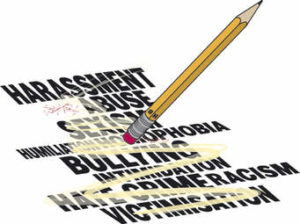By: Robert Avsec, Executive Fire Officer
Bullying and harassment, especially the sexual harassment of women, are problems that continue to plague the fire service.
This video was produced in July 2017 by an IAFC task force group, led predominantly by the Safety, Health and Survival Section, to help the fire and emergency service understand and address the issue of bullying and harassment in the fire service.
Representatives from the IAFC Human Relations Committee, Volunteer and Combination Officers Section and iWomen, as well as other organizations, assisted in the project, which was endorsed by the IAFC’s Board of Directors and 2016-2017 president, Chief John Sinclair.
When I first watched the video, I immediately shared it across my social media channels (Facebook, Twitter, and LinkedIn). Mission accomplished, right?
Then I received the following message from one of my fire service colleagues, a woman who currently serves as a chief officer in a large metropolitan fire and rescue department:
I just watched the bullying video and I wanted a safe place to relay my thoughts – all of the speakers looked older. I don’t think that younger firefighters would relate to this message. I didn’t.
Who was this message intended for? (The music was really nice for such an important message). Ask a viewer in any fire station, who are those people speaking? Most likely they wouldn’t have a clue (I recognized a few). But really – the video could have identified that these were fire service leaders who can stop it [bullying and harassment in the fire service]. What did you think?
My Reaction
Well, first I watched the video again. And then I realized that my colleague was very spot-on in her comments. In  addition to the points she mentioned, I had these thoughts:
addition to the points she mentioned, I had these thoughts:
This is a typical white male fire service attempt to solve a problem. Make a video with predominantly white male speakers, add a couple of fire service minority members for diversity, “check off the box” (task completed), and move on to the next problem.
The video seeks to change the behavior of firefighters and officers by appealing to their “better angels”, i.e., their sense of right and wrong (Stop bullying and harassing your fellow employees or members because it’s the right thing to do). Experts in the field of behavioral change have consistently shown that such an approach is not successful. People change their behavior because they don’t want to be seen as abnormal.
How the video could have been better
Sure, this is an exercise in “Monday Morning Quarterbacking”, but we humans tend to be more receptive when the topic is “fresh in our mind.” Especially with today’s ever decreasing attention spans.
Bullying and harassment in the fire service, as those behaviors are in the general population, are about power and control. Those individuals who engage in bullying or harassment do so because they want to maintain the status quo or they’re seeking to elevate their status among their peers or they’re insecure in their position of official power (officers).
In my opinion, these elements are inter-related just as fuel, heat, and oxygen are critical elements necessary for combustion. If we can successfully remove these elements in our organizations, we can make the fire (bullying and harassment) go out for good.
So, here’s how the IAFC could have done better at “hitting the mark.”
- Lead with a couple of short scenarios with real firefighters acting out what bullying and harassment really look like in the fire service (Get everyone on the “same page” about what the problem looks like).
- Follow each scenario with an alternate scenario showing someone “stepping up” and stopping the bullying or harassment (Demonstrating what the desired new behavior must look like).
- Have speakers that are younger and representative of those most likely to experience bullying or harassment in the fire service, e.g., women, people of color (men and women), people of different nationalities, and people of different sexual orientation. Have those speakers address how it feels to be the target of bullying or harassment by the co-workers or superiors.
- Finish by having current fire services leaders, e.g., women, people of color (men and women), people of different nationalities, and people of different sexual orientation, serve as the “closers” who reinforce the video’s focus: Bullying and harassment have no place in the fire service. And clearly identify who those fire service leaders are.
So, what are your thoughts on this video?

See Related: An unexpected study in firefighter harassment
 Fire & EMS Leader Pro The job of old firefighters is to teach young firefighters how to become old firefighters!
Fire & EMS Leader Pro The job of old firefighters is to teach young firefighters how to become old firefighters!